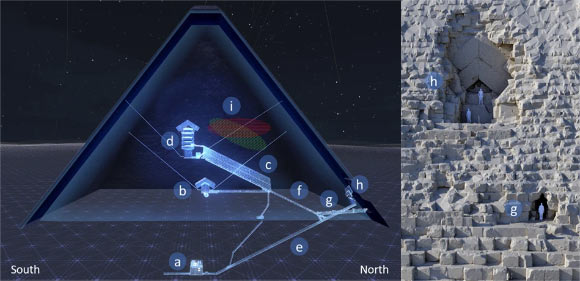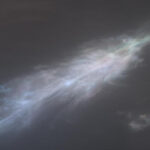Khufu’s Pyramid is one of the largest archaeological monuments all over the world, which still holds many mysteries. In 2016 and 2017, the ScanPyramids team reported on several discoveries of previously unknown voids by cosmic-ray muon radiography. In new research, scientists carried out a precise analysis of the void — about 9 m in length with a transverse section of about 2 m by 2 m — found behind the North Face Chevron and named the ScanPyramids North Face Corridor.
East-West cut view of the Great Pyramid and front view of the North face Chevron area: (a) subterranean chamber; (b) queen’s chamber; (c) grand gallery; (d) king’s chamber; (e) descending corridor; (f) ascending corridor; (g) al-Ma’mun corridor; (h) north face Chevron area; (i) ScanPyramids Big Void with horizontal hypothesis (red hatching) and inclined hypothesis (green hatching). Image credit: Procureur et al., doi: 10.1038/s41467-023-36351-0.
The Great Pyramid is one of the largest stone structures in the world, built 4,500 years ago by the king Khufu, king Snefru’s son, on the Giza plateau of necropolis in Egypt.
It was expected to be over 146 m high, before its smooth outer coating was stripped off by carriers in the Middle Ages as well as the capstone on the top.
Today, the pyramid is 139 m high and 230 m wide, and is thought to be made of several million pieces of limestone, each about 1-2 m high.
There are large internal structures in its massive stone body, connected by narrow corridors in the north-south direction at a distance of about 7 m east from the center of the pyramid.
They are respectively called, from the bottom to the top, the abandoned subterranean chamber, the queen’s chamber, the grand gallery and the king’s chamber.
In 2016 and 2017, a series of new voids were discovered inside the pyramid, including a Big Void and a corridor-shaped structure located behind the Chevron structures on the north side of the pyramid, named the North Face Corridor.
However, the precise position and shape of the North Face Corridor remain unknown.
Using a technique called cosmic-ray muon radiography, Dr. Sébastien Procureur from the Université Paris-Saclay and his colleagues measured the size, shape and location of the North Face Corridor in detail, without entering it.
According to the team, the corridor measures about 9 m in length, and has a transverse section of about 2 m by 2 m.
“North end of the corridor starts at 0.8 m behind the Chevron and ends at 9.1 m southward,” the authors said.
“A horizontal corridor is favored, with a transverse section around 2 m by 2 m.”
“More complex shapes than a simple paralleliped are possible, but with the same mean height and width.”
“To our knowledge, this study is the first characterization of the position and dimensions of a void detected by cosmic-ray muons with a sensitivity of a few centimeters only,” they added.
“On the archaeological side, the discovery of a void located behind the Chevron and having a larger cross-section than the corridors connecting the inner structures of the pyramid may be decisive in approaching the role of this Chevron.”
The team’s paper was published in the journal Nature Communications.
_____
S. Procureur et al. 2023. Precise characterization of a corridor-shaped structure in Khufu’s Pyramid by observation of cosmic-ray muons. Nat Commun 14, 1144; doi: 10.1038/s41467-023-36351-0




